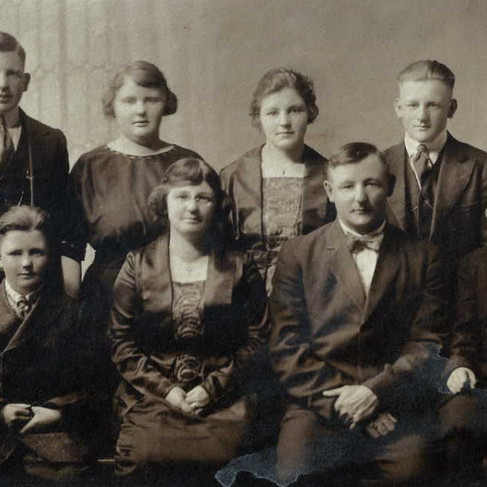
(This post is prompted, in part, by family pictures, ties, and stories that grow more precious with time. "The Short Women Love Their Hats" (above) features Caroline Foster Springer Short, Ruby Short Fox, and Francis--all ancestors of my husband's through his maternal great grandfather Royal Elmo Short.)
Over lunch with my friend Laura last week, I asked her about a book she’s writing. It details her journey from executive assistant to entrepreneur. Laura is vibrant and eloquent and frequently speaks in the financial planning arena. I inferred that her book would provide her with something tangible to market to her audiences once her presentations have ended. “It’s partly that,” Laura agreed. “But what really motivates me to keep writing is the idea that this book is part of my legacy. I think of it as a gift to my great grandchildren, so that they can get to know something about me beyond just a picture in an album.” That caused a chill. The good kind of chill that gets me to thinking. A few days later, listening to a Fresh Air podcast on my way to work, I heard Terry Gross’s guest share these statistics: “Around 44 percent of people can’t name a single one of their great grandparents. Only 11 percent can name all eight of them.” That caused another chill and got me thinking some more, enough so that when I got home, I sat at the computer and pulled up the ancestry record of my own great grandparents. All eight of them.

Going down the list, I recognized a couple names. One was Jay D. Harding, my mom’s maternal grandpa, who married Mary Jolietta Ingersoll, known as Grandma Jolly. They had two daughters, Pearl (my grandma) and Doris (my great aunt). In a rare airing of dirty Harding family laundry (or, as my mother liked to say, “rumor had it...”), Grandma Jolly had an illicit affair with a farmhand, which produced a third little girl, Marion. Apparently, Jay grew despondent knowing Marion wasn’t his and eventually hung himself in the barn.
(Below left, Great Grandpa Jay with daughters Pearl and Doris; right, Jay’s death certificate, which confirms suicide, but by poisoning, not hanging.)
As with most family histories, time blurs fact and fiction until a story is formed. Sometimes the blur is to protect reputations; sometimes it’s simply due to faulty recall. I wish I knew more about great Grandpa Jay, like if he ever felt joy, but I don’t and I’m not going to pretend.
Some might say perhaps we should skip the stories and stick to pictures, which in days of yore weren’t routinely filtered or doctored. Personally, I love old pictures. Good thing, too, because when it comes to memories of my great grandparents, in some cases pictures are all I have.
(Below left, my mother’s paternal grandmother, Agnes Elizabeth [Peters] who, at age 16, married great Grandfather Daniel Prime in Cambridgeshire, England; they immigrated to the U.S. several years later. Below right, my father Doug’s maternal grandparents and their children [from top left]: Kenneth, Marguerite [my Grandma Putt], Thelma, Herbert, Carl, my great Grandma Hattie [Trader], great Grandpa Charles, and Arthur.)
So should we stop sharing family stories because they might not be 100% spot on? I hope not! When it comes to my dad’s paternal grandparents, William Ezra and Elizabeth [Wilmot] Putnam, I don’t have a single photo. I do have stories of their ancestors, though, from a history published by The Salem Press Publishing and Printing Co., Salem, Mass., 1908 (Vol. 2). It tells the tale of how William’s great Grandfather Sylvanus was, as a child, “taken prisoner by the Indians [with] his father, [who] was killed and scalped within sight of the fort which had been built for the protection of the settlers. Sylvanus was then aged thirteen years. For three years he remained a prisoner at Montreal. Father and son were engaged in gathering apples at the time of the attack.” Now there’s a story that creates its own vivid pictures in my mind’s eye.
Other Putnam tales prevail. My fourth great grandfather Seth was, according to his gravestone, an officer in the Revolutionary Army. His son Thomas “is authority for the statement that he was a member of the ‘Boston Tea Party.’” Fact or fiction? Who knows for sure? It fascinates me, though. And it brings to mind a couple things:
(1) We can’t control the actions that our forefathers (and mothers) took in the years before we were here. We can learn about them, maybe glow with pride over some, probably cringe and beg to atone for others. We are not responsible for our history. Yet may we be punished if we fail to learn from it or dare to repeat its atrocities.
(2) The time to learn and share OUR stories is now!

I was reminded of my love of stories again when my good friend Karen and I were out on a goddess cruise on the lake. As we floated on noodles in Flamingo Cove, we talked about the things that women friends discuss. You know, our futures, our husbands, our wrinkles, our lineage, our kids, our fat, our grands, our...everything, as in The World According to Karen and Jan.
Somehow our conversation came around to missing our moms. Karen just recently lost hers. Mine passed in 2012. They both died after lengthy illnesses. We feel sadness, of course, but it’s not like the Facebook brand of sorrow where women proclaim to miss their mothers. Every. Single. Day. I can’t speak for Karen, but I think at times I feel more guilt than grief, over the scantiness of my tears and the relief that my mom's pain is gone.
But...there are times, if not every damned day, when I’d give almost anything to have my mother back by my side. To have one last conversation. To ask questions that will forever go unanswered. To listen just once more, this time with patience and interest, to my mother’s stories.
“When I retire,” I told Karen, “I want to write and play piano and hang out with the grands and travel. But I also want to run workshops to help people share their own stories. Not their histories. Their stories.”

In closing, may I share one of my family's stories with you? It's called “The Mitt.”
The mitt came in a gift bag. It wasn’t the most expensive mitt, but it was nice: a Rawlings – Player Preferred - with an all leather shell. “The Mark of a Pro” was stamped beneath the mitt’s thumb.
Tucked in with it were glove conditioner and a green low-cost practice ball.
I watched, pleased, as the mitt came out of the bag. As with all new mitts, it was stiff and needed breaking in. Dinner could wait, I said, if a game of catch out back sounded appealing.
Beside me on the back porch my daughter Quinn rocked her daughter Charli. Together, we three girls watched three generations of boys toss the ball back and forth in the yard.
The youngest boy, Britton, had trouble catching from time to time. His father Patrick held back on throwing tooooooo hard. He coached with kindness but without cajoling. Then there was Big Daddy, a lifelong baseball lover who’d played his share but clearly felt comfortable taking a back seat in the coaching arena this round.
It was a simple thing, three generations having a catch out back on a breezy June day. It was also so close to perfect that I hated to see it end. When dinner could wait no longer, I called for gloves to come off and hands to be washed before we sat down for our meal.
“Did you enjoy playing catch?” I asked the boy I’ve loved the longest.
“I did,” he replied, his eyes agleam. “Can I tell you something?” he added. “I played a lot of baseball growing up. Sandlot games, mostly, but I always had to borrow a mitt. This is the first mitt I’ve ever owned.”

(Above, Big Daddy and his mitt.)
Someday I hope our grandson Britton will share this story with a grand of his own. Maybe he’ll hold the child on his knee. Or maybe they’ll talk while having a catch. The picture’s a blur, but I hear the conversation clearly. It’s about the special day that a little boy named Britton gave his Big Daddy his very first baseball mitt.
I mean, what kind of life would it be if we didn't take time to share our special stories with the people we love?







